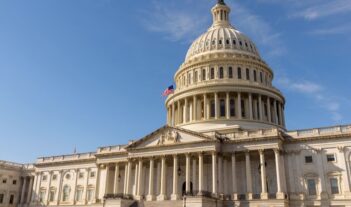
U.S. food stamp programs grapple with a new wave of scrutiny.
For every dollar spent on orange-colored stamps, purchasers received an additional fifty cents worth of blue ones. The orange stamps could buy any food, but the blue stamps were for purchasing surplus foods that otherwise might not have sold.
So began the first food stamp program in the United States, implemented toward the end of the Great Depression to address “unmarketable food surpluses and widespread unemployment.” Unlike earlier efforts to address these conditions—which required farmers to reduce their crops and livestock artificially—this program aided farmers, businesses, and Americans experiencing food insecurity alike.
But this first program was short-lived, ending after just four years.
After a decade and a half of research, advocacy, and failed attempts at legislation, a team of U.S. senators authored the Food Stamp Act, signed into law by President Lyndon B. Johnson. The Act authorized the U.S. Department of Agriculture (USDA) Secretary to administer a food stamp program through which income-eligible households could obtain coupons to purchase food. The Act also delegated the eligibility process and coupon issuance to state agencies and required retailers to apply for authorization to accept coupons.
Since their inception, food stamp programs have ignited criticism from those who fear the programs could permit fraudulent applications for benefits and abuse by retailers. Indeed, the first retailer found to be violating the program did so within the program’s first year. But reporting from the USDA suggests that these concerns may be misplaced, since applicant fraud, misuse of benefits, and retailer fraud are infrequent occurrences.
The present program—called the Supplemental Nutrition Assistance Program (SNAP)—is now weathering significant reform. In fact, a Trump Administration rule that took effect earlier this month could leave 700,000 people without their SNAP benefits.
This week’s seminar explores the benefits individual households and the U.S. economy reap from SNAP, potential ways to improve the program, and the implications of the new SNAP rule.
- According to Diane Schanzenbach of Northwestern University School of Education and Social Policy, “SNAP is an effective and efficient program that is well designed to work with the market.” In an article for The American Academy of Political and Social Science, Schanzenbach asserts the program could be improved “modestly” to reduce food insecurity, improve dietary quality, encourage work among recipients, and minimize costs while stimulating the economy. In particular, she recommends subsidizing healthy foods and adjusting the benefits formula during periods of economic downturn. Schanzenbach cautions against adjusting the means-tested nature of the program, however, attributing the program’s key strengths to this structure.
- Increasing income “can trigger rapid reductions in or termination of SNAP benefits” that can create economic hardships and health risks for families despite the fact of greater income. In a study appearing in Health Affairs, Stephanie Ettinger de Cuba and other researchers investigated the connections between income, SNAP participation, and household stability measures such as food security and family health. They found that families who lose SNAP benefits after an increase in income—and particularly after a short-term increase—experience worse health outcomes and greater economic hardship. Ettinger de Cuba and her coauthors recommend that policymakers instead calculate income as an average over several months and smooth the reduction of SNAP benefits as families increase their incomes.
- As part of The Hamilton Project and Washington Center for Equitable Growth’s volume on antirecession programs known as automatic stabilizers, Hilary Hoynes and Diane Schanzenbach argue that SNAP is among “the most efficient and effective spending programs.” But existing and proposed rules limit SNAP’s effectiveness as an economic stabilizer, Hoynes and Schanzenbach suggest. They propose two reforms to maximize SNAP effectiveness. First, Hoynes and Schanzenbach recommend limiting or eliminating SNAP work requirements. Second, they propose a 15 percent increase to the SNAP maximum benefit when the Sahm recession indicator is triggered. Today, the indicator is triggered when the 3-month average national unemployment rate rises at least 0.5% points above its low of the previous 12 months.
- In a recent report from the Brookings Institution, Lauren Bauer, Jana Parsons, and Jay Shambaugh argue that if the USDA’s new SNAP rule were in effect during the Great Recession, many more people would have been denied relief. Bauer and her coauthors suggest that during economic downturns, SNAP is meant to expand to provide “nutrition assistance to low-income families” as well as “economic stimulus to communities and the economy as a whole.” The new rule severely restricts the ability of states to apply for work requirement waivers, they explain. The result is that “the final rule has eliminated or modified each of the most effective core criteria for work requirement waivers during the Great Recession,” Bauer and her coauthors conclude. They recommend following Hoynes and Schanzenbach’s proposal to tie work requirement waivers to the Sahm recession indicator.
- In its proposed form, a 2019 SNAP rule would cause a larger number of students than USDA projected to lose access to free school meals, Kristin Blagg, Macy Rainer, and Elaine Waxman assert in a report published by Urban Institute. The coauthors suggest that the new rule would cause many schools to lose the ability to provide students free meals through the Community Eligibility Provision (CEP), which provides free meals “to all students if enough are directly certified through social safety net programs.” CEP status is tied to “a range of positive academic, behavioral, and health outcomes for students, including those who are not eligible for free meals based on their family’s income,” and the coauthors argue that students may lose these benefits if their school loses eligibility for CEP—even if some remain individually eligible for subsidized meals.
The Saturday Seminar is a weekly feature that aims to put into written form the kind of content that would be conveyed in a live seminar involving regulatory experts. Each week, The Regulatory Review publishes a brief overview of a selected regulatory topic and then distills recent research and scholarly writing on that topic.



